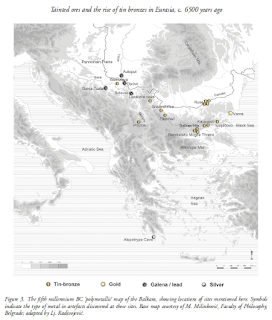Tin is a silvery, malleable metal. It became super important when it was discovered that when mixed with copper, it turns soft copper into hard bronze...
What is interesting is that silvery tin is obtained chiefly from the mineral cassiterite, which is black.
Cassiterite often accumulates in alluvial channels as placer deposits in granite. These deposits can be easily seen in river banks, a feature exploited by early Bronze Age prospectors...
The first evidence of tin use for making bronze appears in the Balkans in mid 5th millennium BC. According to "Tainted ores and the rise of tin bronzes in Eurasia, c. 6500 years ago", the earliest tin bronze artefacts in Eurasia have been discovered in Pločnik, a Vinča culture site in Serbia.
The discovery prompted a reassessment of 14 other early tin bronze artefacts from the Balkans. Apart from Vinča culture sites (Serbia), tin bronze objects were also found in Karanovo-Gumelnita culture sites (Bulgaria) and Gradesnica-Krivodol culture sites (Bulgaria and Romania).
Now these bronzes were not made with cassiterite, but with another tin mineral, stannite. The source of stannite in these early Balkan bronzes is still a mystery...(Last time I checked)
Serbia remained an important metallurgical centre throughout bronze age. Serbia is full of copper. The problem was that until recently, no one knew where the tin for making bronze came from...
However, some geological studies done in Serbia in late 70s and early 80s, stated that alluvial cassiterite deposits were discovered in Cigankulja granite area of western Serbia...Specifically along Milinska reka (Milinska river)
Newer studies
"Placer Tin Ores from Mt. Cer, West Serbia, and Their Potential Exploitation during the Bronze Age"
and
show that the area of western Serbia was actually the most significant source of the alluvial tin in the south of Europe during Bronze Age.
5 bronze age forts was discovered in the area: Spasovine, Likodra, Mali Gradac, Kruglić and Crkvine. The locations of all of the sites indicate a possible connection with tin sources...
This part of Serbia was densely populated during the entire Bronze Age, which can be seen by many tumulus graves excavated in the area...Unfortunately the settlements in the area are far less explored (read almost not at all)...
Hmmm...Some research seem to have been done in the area...
One of the sites, Likodra, actually dates from Eneolithic, from Vinča culture. You can read about it in "Excavations of the Site Ostenjak in the Village of Likodra Near Krupanj"
Anther paper about excavations in the tin ore area is "New archaeological research in the Jadar region of West Serbia, 2010 and 2011"...
And this is super cool 🙂 (I am such a nerd) Experimental archaeology at its best. Extracting cassiterite (tin ore) from the Milinska river sands in the area where the remains of the primitive tin smelting furnaces from late antiquity were found...
Experiment showed that the amount of tin found in the sand was dependant on water level and where the biggest during high water levels. Logical, as tin was literally washed away by the rivers from the deposits 40 km upstream...
Which means that alluvial tin extraction was a seasonal activity. Which explains why there were no permanent settlements in immediate vicinity of the river...
Anyway, lots more cool things (like experimental smelting of tin, copper and making of bronze using replicas of smelting facilities discovered across the Balkans)
can be found in the article: "Jadar: Preliminarni rezultati kampa nje 2017. godine"
From one more interesting paper "Provenance of Tin in the Late Br enance of Tin in the Late Bronze Age Balkans: Pr e Age Balkans: Preparation of ation of Cassiterite for Sn Isotope Analysis and the Probabilistic and Spatial Analysis of Sn Isotopes": Bronze Age sites with some fragments of crucibles with metal-bearing vitreous coatings occur on the river terraces adjacent to the tin bearing Milinska and Cernica rivers on the southern flank of Mt. Cer, indicating on-site exploitation of tin...
Based on isotopic analysis Mt. Cer and Mt. Bukulja were the source of the tin ores used in the Balkans (below Sava and Danube) during the Late Bronze Age...










No comments:
Post a Comment